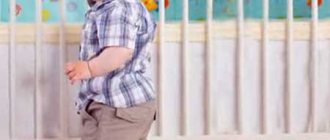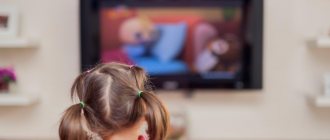Letters surround us everywhere. The child sees them in books and magazines, on food packages, and in store windows. He can't help but wonder what it is. Over time, he begins to understand that adults can read, begins to copy his parents, learning a poem or fairy tale by heart, and pretending that he is reading a book.
Experts recommend teaching a child to read shortly before school, since at an earlier age his brain is not yet ready to perceive such information. You can learn sounds with it, learn to distinguish them in spoken speech, and begin to master the alphabet. This preliterary period is very important, since thanks to it the child will be able to learn to read fluently and understand what he reads.
At what age do you start learning letters?
Many parents are sure that a child’s development should begin almost from the cradle. But neuropsychologists warn that it is harmful to learn letters and numbers before the age of 3. At this age, the emotional and sensory sphere should be formed. If we force a child to study, we violate the laws of brain development, which can have negative consequences.
No specialist will tell you that at 3 or 4 years old a child should know all the letters. Of course, if you wish, you can force him to learn the alphabet, but this will not bring any benefit, and, on the contrary, can do harm. The brain is ready for reading most often by 5-6 years, and only in 20% of children - by 4-5. Before this time, you should not study letters.
But this does not mean that you can forget about the development of the child. At 3-4 years old, you need to work on speech development, teach your child to ask and answer questions correctly, pronounce words, and study the world around him. We need to work on fine motor skills, teach him to dance, develop a sense of rhythm, and so on.
These are the recommendations. However, all children are different. If your child shows a sudden interest in letters, it means it’s time to start learning. And it doesn’t matter if it appeared late, for example, at 6 years old. The child must want to read, only after that you can study with him.
Psychologists note several signs that indicate a child’s readiness to learn:
- The child understands what he reads well and can tell what the book is about.
- He knows how to construct phrases and pronounce all sounds.
- Interested in what is written in a children's magazine, book or poster.
- Pretends to read, imitating adults.
If all these signs appear, you can begin classes. You can’t put pressure on a child, force him to study, bribe him (“if you learn the letters, I’ll give you a chocolate bar”) - you won’t achieve anything with this.
In cases where interest in letters appeared early, there is no need to give up classes. But do not overload your baby, work with him for no longer than 7 minutes, classes do not have to be done every day, you can take breaks of 2-3 days.
Learning the alphabet at 5 years old
At the age of 5 years, a child already consciously shows an interest in reading. He understands that words can be made from letters, and sentences can be made from words. A five-year-old child can independently, without parental prompting, use improvised objects to form letters and sculpt them from plasticine.
An electronic primer will be very useful at this age - it will interest and captivate the child. In this case, it is very important to choose the right ABC book. Letters should be pronounced as the sounds that designate them (not “er”, but “r”, or not “en”, but “n”).
For four- and five-year-old children there is a special workbook “Learning Letters”, which they can use together with their parents or independently.
At this age, the main thing is that the child speaks correctly and coherently. To do this, parents should ask the child to tell something, for example, what he did today, let him retell his favorite fairy tale, and so on.
Where to start learning the alphabet?
The child began to show interest in letters. There is no need to immediately load him with knowledge, cram the alphabet. Move little by little. The easiest way for children to remember is the first letter of their name. Explain to him what this letter is and what it is called. You can ask him to find this letter in the text. Gradually he will learn to highlight it and will pay attention to it. The first step has been taken.
Parents now trust various children's tablets, phones and other similar toys to educate their children. Remember that they are learning to pronounce letters, not sounds. Kids need to be taught sounds, so it will be easier for them to master reading.
A letter is a graphic representation of a sound, each has its own name. But learning to read knowing only the names of letters is very difficult. Imagine that a child will need to read the word “ball”. How will he do this? The way he was taught: “baael.” And all because he pronounces letters, not sounds.
It is better to start learning with sounds, pronouncing them with your child. Parents themselves should not confuse sounds and letters. Sound is what we hear. A bumblebee buzzes is a sound, a hammer knocks is also a sound. But we cannot get words from all sounds. If we clap our hands, the sound will appear, but the word will not.
You can create a word from special sounds called speech sounds. Make sure that the child does not confuse the letter and sound. Explain to him that a letter is an icon that can be seen in a book or drawn on paper. Letters can be seen with our eyes, and sounds we can hear.
How to learn consonants: a game technique
There are many more consonants than vowels. Studying them will require more patience, effort and time. But everything will work out if you strictly follow the recommendations and take your time.
Prepare a table. Each table consists of six rows. On the top line, write or type hard consonants in blue and soft consonants in green. On the remaining lines, write short open syllables.
| BY | |
| BO | BYO |
| BOO | BYU |
| WOULD | BI |
| BE | BE |
| VYa | |
| IN | WHAT |
| VU | VYU |
| YOU | IN AND |
| VE | BE |
| GY | |
| GO | GYO |
| GU | GY |
| Gee | GI |
| GE | GE |
| DY | |
| BEFORE | DE |
| DU | DU |
| YES | DI |
| DE | DE |
| ZY | |
| ZO | ZY |
| memory | ZY |
| PS | ZI |
| ZE | WE |
| LA | |
| LO | LE |
| LU | Best Junior |
| LY | LI |
| LE | LE |
- Together with your child, sing songs of vowel sounds: in a rough low voice A, O, U, Y, E and in a high thin voice I, E, Yu, I, E.
- Say the consonants in the top line of the chart clearly. Work with 6 tables in each lesson.
IMPORTANT! Make sure that the child and you yourself pronounce the consonants clearly, so that no extraneous vowels Y or I . If the child gets used to saying D y, S y instead of the pure sounds D , S , then he will read incorrectly. The most difficult things to pronounce are the pure sounds B, V, G, D; B, B, G, D. The rest are easier, especially the deaf. Z and ZH correctly for example, is very simple. Ask your child: “How does a big mosquito buzz? Z-Z-Z. No, not Z s, but Z-Z-Z! The mosquito does not know how to say Zy , it does Z-Z-Z . How does a small mosquito buzz? ZZ-ZZ-ZZ . Komarik does not know how to say Z and, he does Z-Z-Z-Z . This is what we call these letters: Z-Z-Z and ZZ-ZZ-Z .”
- Sing the syllables in the same way as you did with the vowels.
- b in the tables and tell them that it is called a “soft sign.” Remind him of its name from time to time.
The letter b does not indicate a sound, but only INDICATES the softness of the consonant.
- Write Y . Name what this sound sounds like. Give examples of words that begin with this sound: iodine, yogurt, yogi.
the very name of the letter “ And short” later when he learns the alphabet. From time to time, remind your child about this letter by PRONING IT WITH A SOUND.
- Return to these tables several times a day and sing the warehouses with your child. Do this regularly.
- When you see that the child is doing everything correctly, replace the 2 tables with two new ones.
| MY | |
| MO | MIO |
| MU | Manchester United |
| WE | MI |
| ME | ME |
| AE | |
| BUT | NOT |
| WELL | Nude |
| WE | NI |
| NE | NOT |
The technique is the same. Sing all 6 tables daily with your child. As a result, the child will repeat the old ones and learn 2 new letters.
- Again replace the 2 tables with two new ones, etc.
If you stick to the plan “new things 2 times a week, repeat the rest of the days,” your child will learn 32 letters of the Russian alphabet in a month. Ъ to your child later, when he begins to read and encounters this letter in words.
IMPORTANT! In the Russian language there are twin sounds and warehouses: ZH-ZH, ZH-ZHYO, SH-SH, SHO-SHYO, CH-CH, CHO-CHE, SHCH-SHCH, SHCHO-SHCHYO, TSY-QI . They are spelled differently, but sound the same! Be sure to draw your child's attention to this.
General recommendations for teaching a child
If you decide to study with a child, remember the basic rule - he should be interested. You can't force him. At this age, the easiest and most accessible way to learn is through play.
It is difficult for kids to concentrate and sit in one place for a long time, so classes should be short, 5-10 minutes. As soon as you notice that he is getting bored, move on to something else. If he forgot everything you went through, don’t get annoyed, repeat it again until he remembers. If you overload your child with information, he will develop an aversion to learning.
At an early age, a child develops visual-figurative thinking, and only then - abstract-logical thinking. This means that it is useless to draw letters on paper or a board. You won't be able to learn them that way. For him it will be just a set of dashes.
The child needs visual association. For example, if you are learning the sound "a" you can show him a picture of a watermelon or any other object that starts with that letter. Stock up on soft cubes with letters, bright cards, coloring books, and beautiful colored primers in advance.
You should not learn letters in alphabetical order. It is better to start learning with vowel sounds. The letters that are most often found in speech are studied first, then you can move on to rarer ones.
Interactive technologies for teaching letters
Progress is taking place by leaps and bounds, so now parents have every opportunity to use interactive educational games. Children enjoy learning letters interactively, as it is very educational and interesting.
Talking alphabet for children
The educational alphabet for children not only gives an idea of the letters, but also pronounces them independently. To do this, you just need to press a button. The good thing about the process is that the child can press the buttons independently.
Experimental activities in the preparatory group
For your information! The gadget is designed in a bright style and attracts attention. There may be different sizes and pictures. The poster should hang in a visible place, attracting the child's attention.
When a child presses a button, he hears both the desired letter and a certain word. Extended versions can be supplemented with various melodies or rhymes. Everything is done so that the children's brain learns the language better.
There is a symbiosis that combines teaching the alphabet and numbers. It has the same principle, but is complemented by a digital panel. For example, when you press the “3” button, the number three is announced. There are modifications in the form of full-fledged books. Using them, the child will also be able to study online.
Posters are usually touch sensitive and run on batteries. Overall, it helps children develop knowledge and makes the parent's task easier. Can be used both as a main and an auxiliary element.
Talking alphabet for children
The speaking alphabet has a similar meaning, but is aimed at learning the alphabet.
For your information! In this poster, the letters are in the correct order. The device works on a similar principle. Can have built-in volume controls and declare poems.
The choice depends solely on the baby’s parents.
Letter cubes
How to learn vowels?
First, explain to your child that all words are made of sounds, just like houses are built of bricks. The more sounds a word has, the longer it is. After this, you can move on to studying sounds.
Start with "a" . You can show your child pictures that depict objects whose names begin with this letter. Draw together the mouth that makes this sound, note how we open it wide. Let him try to name words that begin with this letter. Do not overload your child: 1 lesson - 1 letter.
Try to consolidate the acquired knowledge. Here you are going to kindergarten, you saw a pharmacy, let the kid try to find the letter that you studied. We bought a children's magazine, see if there is a letter “a” . You can mold a letter from plasticine or dough, or cut it out of paper. You can lay it out of sticks or sand.
It will be much easier for you to captivate your baby if you always have cubes with letters, bright books, and cards at hand. You can sing a song about a letter or listen to a funny poem.
So, learn all the vowel sounds one by one. Finally, you can explain that the sounds you have already learned are called vowels. These are sounds that can be sung. Try singing “a-a-a” or “oo-oo-oo” .
Remember that we have 6 vowel sounds ( a , o , u , e , s , and ) and 10 vowel letters. The letters i , e , ё , yu consist of 2 sounds. It is better to postpone the study of the latter until later, because there is no sound “I” , I is a letter consisting of 2 sounds.
Do not confuse the child, so that later educators and teachers do not have to retrain him.
How to teach a child the alphabet at 3-4 years old
If you decide to teach your child letters at 3 years old, remember that nothing can be done through force, only games, only entertaining exercises and NO FORCE. These recommendations are relevant for any age, because you do not want to develop an unwillingness to learn and go to school in the future.
- Don't expect your child to remember many letters right away. Don't set out to learn the entire alphabet; it will take time.
- Give your child new material twice a week, and on the remaining days, repeat and consolidate what you have learned.
- With a child 3-4 years old, it is enough to exercise 2-7 minutes a day.
- Learn vowels in pairs, so it will be easier for your child to remember: A - Z, O - Yo, U-Yu, Y - I, E - E.
- Before introducing your child to consonants and starting to learn to read, make sure that knowledge of all vowels has been brought to automaticity.
How to learn consonants?
Once you have learned the basic vowels ( a , u , and , o ) you can move on to consonants. You need to start with the simplest consonants ( b , p , m , n , t , g ). And here again we remember that we teach the child sounds, not letters. We know that we need to say “ um ”, “ en ”, “ be ”, but children don’t need to know this yet. The child must learn that this is the sound “ mm ” or the sound “ nn ”. After the baby has mastered simple consonants, you can move on to studying sibilants.
Just like with vowels, knowledge needs to be consolidated. Children may confuse letters. To prevent this from happening, play association games. You can ask the children to think of what the letter looks like. Look for objects on the street that resemble this letter. For example, you walked past a horizontal bar, it is shaped like the letter “ p ”, or look at the doorway, it is also shaped like a “ p ”. Make it out of pencils, look for it in store signs.
Learning the alphabet: for children 3, 4, 5 years old
The alphabet is the basis of a child’s future knowledge. The desire to be able to read will help him in studying the school curriculum, developing self-esteem, and activating brain activity. The age of students introduces individual characteristics into the learning process.
Problems and difficulties while learning letters:
- Each child is an individual, with his own innate characteristics. One student will be happy to do physical exercises, another will be happy to learn to read, and a third will be happy to draw. Some children are not yet able to overcome the learning process.
- Restlessness of restlessness. The learning process is long and difficult, so some kids do not have sufficient perseverance.
- Lack of motivation. The activity must really attract the children, otherwise learning the alphabet will not attract them. After all, the baby does not know that he will need him in life.
- The baby is not mentally ready.
Child studying
At what age should a child know the alphabet?
Each baby has its own pace. Experts believe that early learning can discourage a young student from wanting to study.
Almost all children can master the alphabet by age five. Until this age, you should look at the child and his level of development. If the baby is ready, then you can start teaching at three or four years old. The first lessons should be fast and fun, otherwise all the success will be lost. When we teach letters for 3-year-old children, special conditions should be created. The material, according to the methodology, should be presented as if the child was asking him to teach him to read. If a child can only memorize, he is not ready.
Note! If parents see that the baby is not ready, they should wait a while and start again.
Even if the child is not ready, parents can resort to tricks and do mini-lessons in a game format. Then he will not understand that he is being taught.
Experts unanimously support that a child who goes to school should know letters and sounds.
Alphabet for children
How to correctly pronounce the letters of the Russian alphabet to teach a child?
As a result of teaching a child the alphabet, he develops the correct pronunciation and understanding of sounds for each letter. Therefore, when teaching, adults must pronounce letters and sounds correctly.
The child’s brain will have a hard time accepting further attempts to change the material studied, and perhaps the child will continue to pronounce them:
- Strictly follow the transcription. Sounds should not be softened unless required. The child should know that the correct pronunciations are “em”, “en” and “te”. If you tell a child that these are “Me” and “Ne,” he will only get confused.
- The teacher's pronunciation must be impeccable.
- The sounds can be sung or narrated in poetic form. This will introduce an element of play and help the child remember the alphabet faster.
- Take your time with specific letters. For example, with a soft sign. It's better to leave it for later. You can come up with an entertaining story for a boy or girl about why a soft sign became soft.
- At the initial stages, you should pronounce sounds, and only then proceed to letters.
Pronunciation of letters
What to do if your baby doesn’t want to learn letters?
How to learn letters if the baby refuses to do it? First of all, parents must understand that their readiness for learning should be assessed.
For your information! If a child is not ready mentally, there is no need to try to force him - “forced” training traumatizes him. You should make sure that he himself comes and asks you to help him master the alphabet.
You should develop your baby’s interest and come up with games. Do not set strict lesson hours, but teach in a different place, at a different time. For example, in the park. An informal setting often produces unexpected results. For every success he should be praised and given a chance to watch “Luntik”. You can select several games and let your child choose the one he wants to play.
Baby doesn't want to study
It is worth taking the activity to the proper level. The lesson should be, at a minimum, not boring, and ideally, very interesting. Do not criticize, show by example in practice what action should be. Use flashcards or other teaching materials. Encourage and notice all his zeal. You can't shout.
GCD for drawing on the topic “Vase with flowers” in preparatory groups
Note to parents! A baby who does not understand that he is being taught perceives the learning stage more easily and takes initiative in the lessons. He should make the study of letters his own desire. The result can be the studied material and some kind of prize.
Methods for learning the alphabet
There are several popular methods for teaching children to read and memorize the letters of the alphabet. You can use them, especially since experts worked on them. But, no matter what method you work with, it is important to remember that your classes should not resemble lessons at school.
Children at this age need to play and get the information they need through games. Therefore, after a short educational part, immediately move on to an interesting, gaming part. Creative activities are also very useful, with the help of which you not only learn letters, but also develop the child’s fine motor skills, improve his drawing and coloring skills, and strengthen the ability to use scissors.
Games and play exercises
There are a huge number of game exercises that will help you consolidate your knowledge. We will give a few as examples.
1. Find words with the right sound . You need to prepare cards that show different objects. The child must choose among them those that contain the sound being studied. First, you can simplify the task: ask him to find words starting with this letter.
2. Catch the sound . To warm up a little, mother and child walk around the room. Mom says different words. As soon as the child hears a word with the desired sound, he stops and claps his hands.
3. Come up with a word . Ask your child to come up with as many words as possible with a certain sound. You can do this in turn, for example, first the mother says the word, then the baby.
The task needs to be made more difficult, that is, the sound can be not only at the beginning of the word, ask him to come up with a word in which this sound will be at the end or in the middle. For example, you are learning the sound “a”. First, select words that begin with this letter - apricot, orange, then those that end in “a” - Moscow, jellyfish or contain the sound “a” in the middle - mosaic, eye.
4. Determine where the sound is hidden . You need to draw a simple diagram of the word: three squares connected to each other. Each square represents its own: the beginning of the word, the middle and the end. Place this word diagram in front of the child and give him the chip.
You name different words, and he should show on the diagram where the sound you are going through is located. For example, if you named the word “watermelon” (you can show a picture), the child should put the chip in the 1st cell, and if the word “fox” - then in the 3rd cell.
5. Playing with the ball . An adult throws a ball to the child and says different words. If they contain the letter being studied, he catches the ball, if not, then he does not catch it. To begin with, you can use words in which this letter is at the beginning, then complicate the task, that is, it can be in the middle or at the end.
Author's methods for learning the alphabet
There are several recognized methods of teaching reading, each of which can be devoted to a separate article.
Zaitsev cubes
The basis of Zaitsev’s method is play, that is, children simply play with cubes (there are 52 cubes of different sizes in a set) and at the same time learn to read without making any effort. These games can be started from 6-12 months, but until 2 years old they are used like regular blocks, and children after 2 years old can begin to form words.
Zaitsev's main unit is a warehouse. It can consist of a consonant and a vowel, or of one letter. The basis of this method is the warehouse principle of reading. In addition to the cubes, a large storage table is also used.
This technique has many advantages, the main one of which is that any child can be taught to read. But there are also some disadvantages, for example, over time, children will have to be retrained, because they remember that letters are indicated by one color, and the teacher introduces his own colors, for example, red is a vowel letter. In addition, the child is accustomed to the fact that words are divided into clauses, and not into syllables. And benefits are very expensive.
Doman cards
Neurosurgeon Glen Doman developed his technique for children with central nervous system disorders, but then they began to use it to teach healthy children. He recommends teaching children to read not by letters, but by words, since letters mean nothing to him, and words have real meanings.
To do this, whole words are written on cards in large font (at least 7-10 cm), for example, “mom” or “dad,” which must be quickly shown to the child, voicing each word. Using this method, you can teach even a small child to read. Training must be carried out at an early age; after 5 years, Glen Doman’s method no longer works.
Methodology of Olga Soboleva
The principle of this training is based on the “bihemispheric” work of the brain. The teacher tries to use the dominant type of memory, that is, the material is divided into 3 groups: for kinesthetic, visual and auditory learners.
Many of its techniques are also used by ordinary teachers when teaching traditional methods to make it more interesting for children to study. Good for creative children and parents, it is not recommended for families where logic and structure come first.
Polyakov's technique
Its author came up with 7 steps of learning to read, a total of 70 lessons. Each lesson is described in detail. They are conducted in a playful manner and take no more than 10 minutes. Stages 1 and 2 are the study of letters, spellings, reading by spellings.
Sergei Nikolaevich Polyakov himself, unfortunately, is no longer alive, but his work was continued by his son, as well as teachers who practice this method. If you wish, you can purchase books that describe in detail how to conduct classes, as well as video files with examples of classes.
How to teach a child to memorize letters: techniques
There are many interesting and easy ways and techniques in the world to learn the alphabet. They can be presented both in a classic form and in the form of computer games, modeling or special coloring books.
Letter coloring pages
Classic techniques
The basic option for learning the alphabet is to use cards with letters, syllables and images to consolidate associations and develop visual memory. ABC is also a great option to teach basic literacy.
Note! During learning, you should not rush; if the child is tired or has stopped studying, it is difficult for him to remember new things, it is worth taking a break and returning to this moment later.
First, you should memorize the basic vowels (O, U, A, I), and after that move on to simple consonants (M, N, T, B, P, G). The child must learn to pronounce not the name of the letter, but its pronunciation. That is, not “ZhE” “EN” “BE”, but “LJ”, “NN” and “BB”. You should start learning hissing sounds later, when the baby remembers simpler sounds.
It is necessary to teach letters to study both at home and in the fresh, especially summer air: it is worth getting the child interested in recognizing previously learned letters on children's and adult billboards, signs, and English inscriptions online in games.
Author's methods
All conditions have been created, a large number of proprietary methods to learn letters, sounds and the alphabet. Each method has its own advantages and disadvantages.
Experimental activities in the senior group
Important! You should not try to use and combine all methods at once. It is worth focusing on the technique that is comfortable and interesting for the baby to work with.
Learning letters: Polyakov’s game technique
The basis of Polyakov’s method is multiple showing and voicing groups of symbols with their gradual replacement. In the Russian language, groups of rhyming vowels are formed (E-E, A-Ya, O-Yo, Y-I, U-Yu).
The duration of classes is only 7-10 minutes, the frequency is 2 times a week. In your free time, you need to consolidate previously covered material.
This technique uses letter cards and a playful approach, which makes the process easier and more interesting for the child.
Zaitsev cubes
Cubes will help in learning to read from 2 years old. Learning occurs like an exciting game, during which children will begin to read much earlier than they get bored with the activity.
Principles of Zaitsev’s technique:
- Systematic presentation of information.
- Visual presentation of information that uses different channels of perception.
- Presentation of information from specific to general and vice versa.
The main principle of the methodology is teaching not by syllables, but by warehouses. Arrangement is the consonance of a consonant and vowel sound, a separate vowel sound in the form of a syllable or a separate consonant sound in a closed syllable, as well as a consonant with a soft or hard sign.
Doman cards
Doman cards
From birth, the brain is tuned to study and understand the world around us. With this feature, you can begin successful early learning. The technique helps to develop a thirst for knowledge, lays the foundation for a high level of intelligence and helps to learn early reading.
Note! You can use Doman cards for learning from the age of six months.
They represent an image and a word-inscription denoting it. Most often, they are presented in thematic sets.
The sequence is built from simple to complex: it starts with simple words, then phrases and simple sentences are studied, then they move on to common sentences and begin to read.
Methodology of Olga Soboleva
Olga's technique is a creative approach to the process of learning sounds and letters, where the dominant type of memory is involved. The learning process is divided into three information sections for:
- visuals;
- kinesthetics;
- auditory
The learning process is based on a game form with a smooth transition to working with books. It is necessary to help the child love the printed word, and not be afraid of it.
Recommended age for starting classes is 3-4 years.
"Igrobookvote" - a step-by-step method of teaching reading
“Igrobookvote” is an innovative technique designed to help children in such a difficult task as learning to read. Its peculiarity is that it does not aim only to teach the child to read. Technology aims to teach a child to read and write. An important place is given to children's literacy.
For your information! You can start learning to read as soon as your baby is ready. With positive results, from 5-6 years old you can move on to the level of learning to write.
Stages:
- The initial stage involves learning letters. For studying, you should make sure that the letters are large. The baby should see them regularly. This way they will be better remembered in his memory. It is advisable to show a picture corresponding to the letters with the letter. For example, "S" is an owl. The creator of the program pays special attention to sound pronunciation. The sound should be written as it is pronounced. This will save the child from confusion and misunderstanding. Particular attention should be paid to signs in public places and the child should be encouraged to read them. Having seen the previously completed letter, you need to show it to the child on the sign. For all unclear questions, explanations must be given immediately. For teaching, methods are used that the baby will like. Any toys that produce results can be used. You can use letter blocks, puzzles, cut out letters yourself, and use various role-playing games containing letter elements. You should start with light elements, gradually making the process heavier.
- Having dealt with the question of how to learn letters, you should teach your child how to form syllables. Training from simple to complex. The child is provided with visual pictures. In order to make it easier to understand the connection of syllables, you need to visualize the process. The child is provided with pictures showing how to connect the letters. It could be a letter that came to visit another letter, or maybe the letters are traveling like a train. You should give tables with syllables that the baby reads in different directions. If necessary, prompt the child, you should do this in syllabic form, and not in letters. Letters can be printed non-standard, with an interesting design.
- After the previous stage has been brought to automaticity, they begin to form words. It is recommended to choose the simplest words, increasing the load. The words are read several times, at different paces. Labyrinths where the child reads a word and finds it in a picture will be useful. "Igrobook" contains puzzles and exercises of varying complexity with letters, syllables, and words.
- The next stage is characterized by the composition of phrases and sentences. The child should not think about what he is reading. If he does not read, but makes every effort to read, it is better to bring the previous stages to automaticity. The child should not think out the text or add letters.
For your information! Using these rules, mom and dad will help the baby master complex science. The main thing is to make it clear to the baby that regardless of his individual characteristics, he will always remain a loved one in the life of his parents.
Tips for parents on organizing classes
In order for a child to learn the alphabet with interest and pleasure, it is important to correctly organize home lessons, which in no case should tire you. A simple rule applies - it is better often, but little by little, so that the preschooler looks forward to the next lesson, and does not get tired, repeating the same thing. In addition, you should adhere to the following simple recommendations:
- Only game form.
- An atmosphere of fun and goodwill should reign in ABC lessons.
- The child should be praised for any success; there is no need to scold him at all.
- The short duration of training is compensated by their frequency. You can practice for 10 minutes, even 2-3 times a day, if the child is ready for this and shows interest.
- Use a variety of techniques and games to keep things interesting.
- A clear example should always be before your eyes; in preschool age, the role of involuntary memorization is great, so you should, together with your child, choose in the store or make with your own hands a bright colorful poster with the alphabet, which should be hung in a prominent place in the nursery.
- Use associations. The letters “F” and “Z” do not say anything to the child, but the images of “a toad and a snake who are friends, that’s why the letters are nearby” will be deposited in the head, and accordingly, part of the sequence will be remembered.
It is important for parents to do everything so that their kids do not lose interest; their memory is very flexible, so if they play with letters, they will quickly remember their location. But regaining lost interest in studying is much more difficult.
Maria Montessori Method
Italian teacher Maria Montessori proposed a way through which children learn to read on their own, without the help of special aids and alphabet books. According to Montessori, children should first learn to write rather than read, since it is easier for babies to write (i.e. draw) a letter. In addition, you should start with capital letters, not printed ones - circular movements are easier for children. The hand preparation letter begins. To do this, children are asked to shade the drawing and draw frames. Montessori attached great importance to touch, so babies are allowed to touch soft and fluffy letters. In parallel with writing, children learn to read. Using a moving alphabet, they compose words and, subsequently, phrases. And even later, handwritten letters move on to printed ones. The main condition for this is the game, the use of a fairy tale. The exercise game begins with a presentation. That is, parents should tell and show what can be done with certain objects: “Here are soft letters. We’ll trace them with our finger and call them.” Next, the child is given the opportunity to play with these objects without disturbing her or interfering. This game ends with putting the letters into a box, books onto a shelf, and the like. Order is also an important element of the Montessori method.
Glen Doman Method
It arose back in the 40s of the 20th century, when the American neurophysiologist Glen Doman began developing a rehabilitation program for children with lesions of the nervous system. The idea is that the child learns to read words immediately, and not letter by letter. To do this, parents write in red on rectangular cards in large block letters the names of objects that the child often sees. You can find ready-made cards for sale. Then they show these cards to the child many times, while simultaneously saying the word. In addition, mom or dad simultaneously show the object, which is called this word. The child remembers what he saw and heard and subsequently begins to read himself. Gradually the number of cards increases, and therefore the number of words increases.











